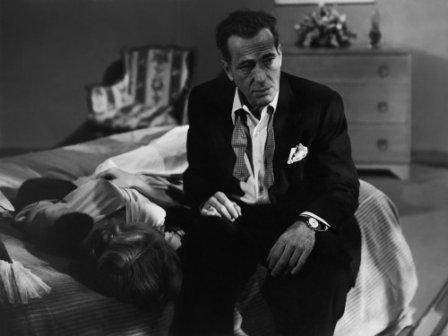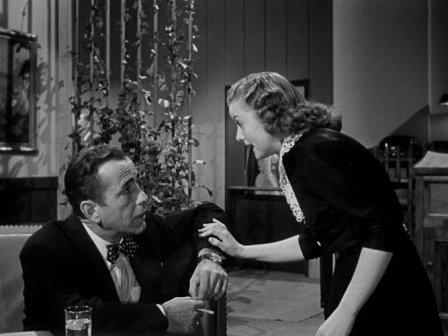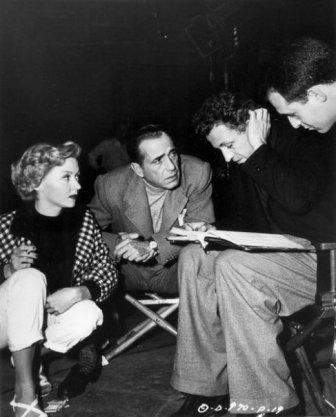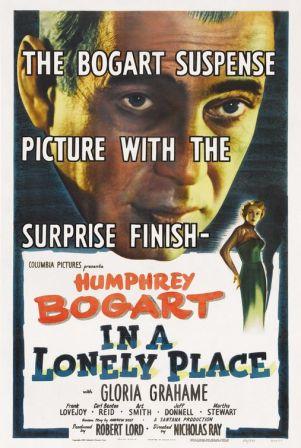“I was born when she kissed me. I died when she left me. I lived a few weeks while she loved me.”—Dixon Steele
At the end of the 1940s and the first year of the ’50s, after two great Humphrey Bogart films in a row, The Treasure of the Sierra Madre and Key Largo, both in 1948, the actor experienced a three-picture slump—Knock on Any Door, Tokyo Joe and Chain Lightning—before he hit upon a script which thoroughly excited him.
At this time in his career, Bogart was intent on extending, and deepening, his loner, tough-guy image that had been established with Casablanca in 1942, to a lesser degree even earlier. Before the actor would play a newspaper editor in Deadline – U.S.A. (1952) and a Hollywood producer in The Barefoot Contessa (1954), he played a Hollywood screenwriter In a Lonely Place.
Even the title is ideal for a loner. A “lonely place” isn’t a physical location as such, an apartment, a house, a car, a bar or a theater; it’s all of these because it’s wherever Dixon Steele finds himself. The loneliness goes with him. Portable, ever-present, sometimes suffocating.
Bogart’s role as Dixon was a hard one for him—not in the acting of it, because the character seemed to come naturally to him. As many thought, Dixon Steele came the nearest to the real Bogart as any part he had played—critic Louise Brooks, for one, has said so. And for that reason, perhaps, it was never one of the actor’s favorite films: it came too close.
 Dixon is decidedly unlikable, opinionated, sullen, a drinker, prone to sudden anger, often leading to the physical abuse of others. He’s in search of love—needs a corrective, connecting, rehabilitating love. When he does encounter it, in that lonely place that is himself, it’s only briefly, too brief to be of any benefit. In the end, he throws the love away.
Dixon is decidedly unlikable, opinionated, sullen, a drinker, prone to sudden anger, often leading to the physical abuse of others. He’s in search of love—needs a corrective, connecting, rehabilitating love. When he does encounter it, in that lonely place that is himself, it’s only briefly, too brief to be of any benefit. In the end, he throws the love away.
Possibly, Dixon’s salvation comes from a single, self-confident woman across the courtyard from his apartment, coincidentally an aspiring actress. Laurel Gray is played by Gloria Grahame, one of the most dynamic, versatile actresses of film noir; she might even be regarded as thewoman of film noir.
At one point, he asks her how she likes a line he’s considering for a screenplay: “I was born when she kissed me. I died when she left me. I lived a few weeks while she loved me.” Some screenwriter: it sounds written, uncolloquial, much like Cary Grant’s line to Claude Rains about Ingrid Bergman in Notorious (1946): “I knew her before you, loved her before you, but I wasn’t as lucky as you.”
From his agent, Mel Lippman (Art Smith), the unemployed Dixon receives a novel for possible screen adaptation. Before leaving the restaurant, he discovers the hat check girl, Mildred Atkinson (Martha Stewart), has, another coincidence, read the book, and he invites her to his apartment to relate the plot to him.
 (Stewart’s performance is the most jarring part of the film, seemingly out of place. She acts like a teenager—naive and silly—and, not helping, George Antheil’s score underlines her ditsy behavior in appropriate film comedy fashion. The comedy in the film, by the way, is intermittent, hardly enough to relieve the angst and tension, and when it is attempted, done feebly.)
(Stewart’s performance is the most jarring part of the film, seemingly out of place. She acts like a teenager—naive and silly—and, not helping, George Antheil’s score underlines her ditsy behavior in appropriate film comedy fashion. The comedy in the film, by the way, is intermittent, hardly enough to relieve the angst and tension, and when it is attempted, done feebly.)
Having paid Mildred for summarizing the novel, Dixon sends her home that evening. There is never any hint of impropriety for she isn’t his type. The next morning he is awakened by Brub Nicolai (Frank Lovejoy). Seems Mildred has been brutally murdered, apparently tossed from a car. Dixon suggests that his new neighbor might have seen Mildred leave his apartment and, indeed, Laurel provides an alibi. She’s in the habit of watching him because “she likes his face.”
At the suggestion of his boss, Captain Lochner (Carl Benton Reid), who is still suspicious of Dixon, Brub invites Dixon over for dinner with his wife, Sylvia (Jeff Donnell). The two men discuss Mildred’s murder. Dixon sets up a frightening re-enactment with Brub and Sylvia sitting in two straight chairs, representing the front seat of a car and having Brub wrap an arm around his wife’s neck.

Dixon’s intensity and wide-eyed look, leaning forward edgily, emphasized by a key light on his face, easily suggest that he might be guilty. Sylvia is frightened by the realism of the demonstration.
“I’ve killed dozens of people in pictures,” Dixon says. “No, . . . I could never throw a lovely body from a moving car. . . Creative artists have a respect for cadavers. We put them in soft beds, lay them on fur rugs, at the foot of a staircase, but we could never throw them from a car like cigarette butts.”
When Dixon and Laurel begin seeing one another and fall in love, he is more at ease with himself, less agitated and nervous, and stops drinking and resumes writing a screenplay. The couples’ actions suggest they are living together—in 1950s Hollywood?—yet at other times Dixon crosses the courtyard to visit Laurel.
An actor, Charlie, down on his luck, pops up at various times, drunk and spouting Shakespeare. (Actor Robert Warwick needed work, and Bogart insured he had a part in the film, in appreciation for Warwick’s past kindnesses to him. His appearances are unnecessary and impede the plot.)
Reacting to Laurel’s apprehensions that he isn’t safe to be around, the flustered screenwriter nearly causes a car accident. When he beats up the other driver, only her intervention prevents him from smashing the man’s head with a rock.
 Later, when Dixon proposes marriage, Laurel accepts to avoid another confrontation. Then she is caught packing to leave and he almost chokes her. Only a timely phone call saves her. Brub tells her that Mildred’s boyfriend has confessed to her murder and Captain Lochner comes on the line to apologize for his suspicions about Dixon.
Later, when Dixon proposes marriage, Laurel accepts to avoid another confrontation. Then she is caught packing to leave and he almost chokes her. Only a timely phone call saves her. Brub tells her that Mildred’s boyfriend has confessed to her murder and Captain Lochner comes on the line to apologize for his suspicions about Dixon.
“Yesterday this would have meant so much to us,” she tells Lochner. “Now it doesn’t matter at all.” As Dixon, physically and emotionally spent after their fight, leaves for good, crossing the courtyard to his apartment, Laurel says to herself, partially quoting Dixon’s earlier line, “ ‘I lived a few weeks while you loved me.’ Goodbye, Dix.”
Maybe, now, that line sounds a little more natural.
[embedyt] https://www.youtube.com/watch?v=Cq9VYIrFy3M[/embedyt]
